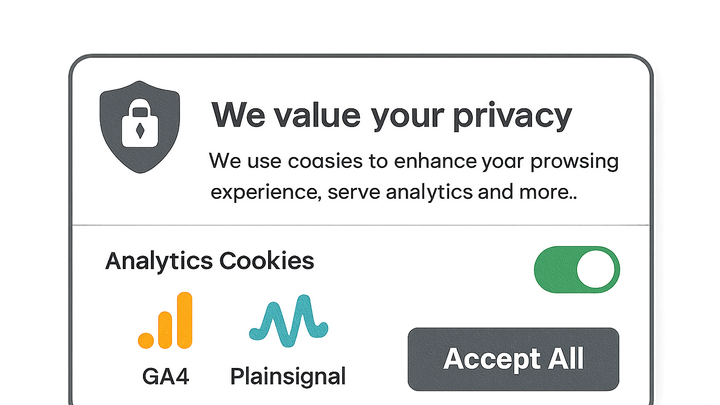Published on 2025-06-28T03:36:43Z
What is Tracking Consent? Examples for Tracking Consent.
Marketing analytics often rely on tracking user behavior via cookies and other identifiers. Tracking Consent refers to the legal and ethical process of obtaining user permission before collecting their data for analytics. It ensures that organizations comply with regulations like GDPR and CCPA and respect user privacy preferences. Tracking Consent can be managed through banners, pop-ups, or consent management platforms (CMPs) that record user choices. By implementing transparent consent flows, businesses build trust with users while maintaining valuable analytics insights. Modern solutions such as PlainSignal (cookie-free analytics) and Google Analytics 4 consent mode offer ways to honor consent status seamlessly.
Example integration with PlainSignal:
<link rel="preconnect" href="//eu.plainsignal.com/" crossorigin />
<script defer data-do="yourwebsitedomain.com" data-id="0GQV1xmtzQQ" data-api="//eu.plainsignal.com" src="//cdn.plainsignal.com/plainsignal-min.js"></script>
Tracking consent
Tracking Consent is the process of obtaining and managing user permission for analytics, ensuring compliance with privacy laws like GDPR and CCPA.
Why Tracking Consent Matters
Tracking Consent is crucial for legal compliance, ethical data handling, and maintaining user trust. Without proper consent, analytics data collection can lead to fines and reputational damage.
-
Legal compliance
Regulations like GDPR and CCPA mandate explicit user permission before tracking. Fines for non-compliance can reach up to 4% of annual global turnover under GDPR.
-
User trust and transparency
Offering clear choices builds trust and can improve opt-in rates. Transparent consent experiences signal respect for user privacy.
-
Data quality
Collecting consented data ensures your analytics accurately represent willing participants, reducing bias and improving decision-making.
Regulatory Frameworks
Understanding key privacy laws helps implement compliant tracking strategies that respect user rights.
-
Gdpr (eu)
Requires opt-in consent for most cookies and personal data processing. Users must be informed and able to withdraw consent as easily as they give it.
-
Ccpa/cpra (california)
Gives California residents the right to opt out of data sale. While CCPA focuses on sale of personal data, CPRA expands these rights and introduces opt-in for sensitive data.
-
Eprivacy directive
Also known as the Cookie Law. It governs the use of cookies and similar tracking technologies in the EU, requiring prior user consent.
Implementing Tracking Consent
Technical integration involves configuring your analytics tools and consent platform to respect user choices in real time.
-
Using PlainSignal (cookie-free analytics)
PlainSignal automatically avoids cookies and personal identifiers, simplifying consent management. Simply include the provided script and you’re cookie-free by default.
-
Configuring GA4 consent mode
GA4 offers Consent Mode to adjust data collection based on user consent flags (analytics_storage, ad_storage). You must update your gtag.js or Google Tag Manager settings accordingly.
-
Enable consent mode
Set the default consent states and update them dynamically when users give or withdraw consent.
-
Tag configuration
In Google Tag Manager, configure tags to fire only when the corresponding consent is granted.
-
-
Example code snippet
Embed the PlainSignal script after the user consents to analytics. Use a two-step loader or integrate with your CMP to control script injection.
-
Html snippet
<link rel="preconnect" href="//eu.plainsignal.com/" crossorigin /> <script defer data-do="yourwebsitedomain.com" data-id="0GQV1xmtzQQ" data-api="//eu.plainsignal.com" src="//cdn.plainsignal.com/plainsignal-min.js"></script>
-
Best Practices for Consent Experience
Designing user-friendly consent flows improves compliance and user satisfaction.
-
Clear language
Use plain, non-technical language to describe what data is collected and why.
-
Granular controls
Allow users to opt in or out of specific categories (e.g., analytics, marketing).
-
Easy withdrawal
Provide a straightforward way for users to change or withdraw their consent at any time.
